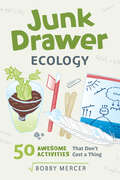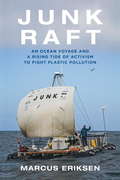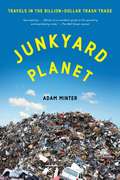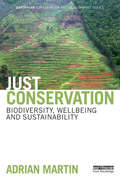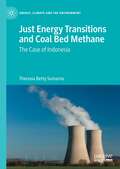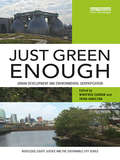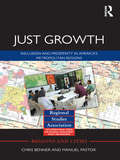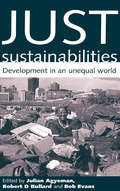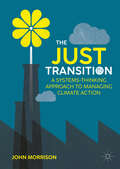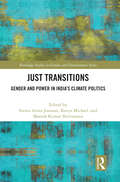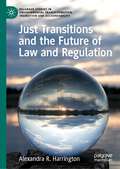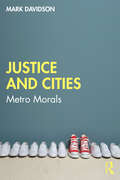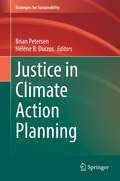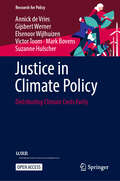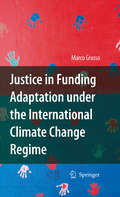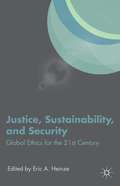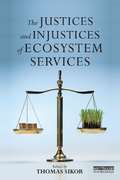- Table View
- List View
Jumping Fire: A Smokejumper's Memoir of Fighting Wildfire
by Murry A. TaylorThis &“terrifying, grimly funny&” memoir about fighting forest fires in Alaska offers &“an affectionate portrait of a fraternity of daredevils&” (The New Yorker). A Los Angeles Times Best Book of the Year Fighting fires since 1965, legendary smokejumper Murry A. Taylor finally hung up his chute after the summer of 2000—the worst fire season in more than fifty years. In Jumping Fire, Taylor recounts in thrilling detail one summer of parachuting out of planes to battle blazes in the vast, rugged wilderness of Alaska, with tales of training, digging fire lines, run-ins with bears, and the heroics of fellow jumpers who fell in the line of duty. This unique memoir, filled with humor, fear, tragedy, joy, and countless stories of man versus nature at its most furious, is a &“tale of love and loss, life and death, and sheer hard work, set in an unforgiving and unforgettable landscape&” (Publishers Weekly). &“Filled with adventure, danger and tragedy.&” —The New York Times Book Review &“A beautifully crafted, wise yet thrilling book.&” —Los Angeles Times
Junk Drawer Ecology: 50 Awesome Experiments That Don't Cost a Thing (Junk Drawer Science #7)
by Bobby MercerKids of all ages can use recycled and repurposed household items to complete exciting and green ecology experimentsJunk Drawer Ecology is a hands-on guide to saving the planet. Fun, free science activities help kids of all ages learn about the science of our planet's ecology. The environment is changing every day, and we can help slow that change. Using free or low-cost things children already have around their homes, these activities are perfect to stimulate young brains. Readers will learn about the importance of the polar regions without leaving their communities, about new ways to cut our dependence on fossil fuels, about all forms of pollution, and how they can make a difference.Junk Drawer Ecology will give inquisitive kids many hours of fun and help them learn at the same time.
Junk Raft: An Ocean Voyage and a Rising Tide of Activism to Fight Plastic Pollution
by Marcus EriksenAn exciting account of an activist scientist’s unorthodox fight in the growing movement against plastic marine pollution and of his expedition across the Pacific on a home-made “junk raft”News media brought the “Great Pacific Garbage Patch”—the famous swirling gyre of plastic pollution in the ocean—into the public consciousness. But when Marcus Eriksen cofounded the 5 Gyres Institute with his wife, Anna Cummins, and set out to study the world’s oceans with hundreds of volunteers, they discovered a “plastic smog” of microscopic debris that permeates our oceans globally, defying simple clean-up efforts. What’s more, these microplastics and their toxic chemistry have seeped into the food chain, threatening marine life and humans alike.Far from being a gloomy treatise on an environmental catastrophe, though, Junk Raft tells the exciting story of Eriksen and his team’s fight to solve the problem of plastic pollution. A scientist, activist, and inveterate adventurer, Eriksen is drawn to the sea by a desire to right an environmental injustice. Against long odds and common sense, he and his co-navigator, Joel Paschal, construct a “junk raft” made of plastic trash and set themselves adrift from Los Angeles to Hawaii, with no motor or support vessel, confronting perilous cyclones, food shortages, and a fast decaying raft.As Eriksen recounts his struggles to keep afloat, he immerses readers in the deep history of the plastic pollution crisis and the movement that has arisen to combat it. The proliferation of cheap plastic products during the twentieth century has left the world awash in trash. Meanwhile, the plastics industry, with its lobbying muscle, fights tooth and nail against any changes that would affect its lucrative status quo, instead defending poorly designed products and deflecting responsibility for the harm they cause.But, as Eriksen shows, the tide is turning in the battle to save the world’s oceans. He recounts the successful efforts that he and many other activists are waging to fight corporate influence and demand that plastics producers be held accountable. Junk Raft provides concrete, actionable solutions and an empowering message: it’s within our power to change the throw-away culture for the sake of our planet.
Junkyard Planet: Travels in the Billion-Dollar Trash Trade
by Adam Minter<p>When you drop your Diet Coke can or yesterday's newspaper in the recycling bin, where does it go? Probably halfway around the world, to people and places that clean up what you don't want and turn it into something you can't wait to buy. In Junkyard Planet, Adam Minter--veteran journalist and son of an American junkyard owner--travels deep into a vast, often hidden, five-hundred-billion-dollar industry that's transforming our economy and environment. <p>With unmatched access to and insight on the waste industry, and the explanatory gifts and an eye for detail worthy of a John McPhee or a William Langewiesche, Minter traces the export of America's junk and the massive profits that China and other rising nations earn from it. What emerges is an engaging, colorful, and sometimes troubling tale of how the way we consume and discard stuff fuels a world that recognizes value where Americans don't. Junkyard Planet reveals that Americans might need to learn a smarter way to take out the trash.</p>
Just Bats
by M. Brock FentonBats are dangerous to man. Right? Wrong. Here is the truth about chiroptera, the only mammals that fly, in a short, well-illustrated account based on solid research but intended for a general reader. Bats, of which there are about 850 species in the world, are maligned as carriers of rabies (largely untrue) and admired for their biosonar. Heir diversity is reflected in their diets: some eat fruit, some nectar and pollen, other fish, birds, frogs, or other bats. Although most eat insects, it is the three species of blood-feeding vampires which receive most public attention and around which much myth and superstition (and misconception) have evolved. In addition to their diet and habit, Fenton discusses their remarkable sonar sight, their reproduction, migration, patterns of behavior ? from hunting to mating ? parasites, enemies, and life span. (The current record is held by an Ontario Little Brown Bat which in 1980 had survived more than 30 years. ) Man?s attitude toward bats, his destruction of their habitats, and his use of pesticides have contributed to a sharp decline in the bat population in many parts of the world. Many biologists are becoming increasingly concerned about the survival of some species, but maintaining their numbers requires a change in people?s attitudes. Just Bats will help. It will also tell the reader how to evict bats from his attic ? provided he knows how they got in.
Just Conservation: Biodiversity, Wellbeing and Sustainability
by Adrian MartinLoss of biodiversity is one of the great environmental challenges facing humanity but unfortunately efforts to reduce the rate of loss have so far failed. At the same time, these efforts have too often resulted in unjust social outcomes in which people living in or near to areas designated for conservation lose access to their territories and resources. In this book the author argues that our approach to biodiversity conservation needs to be more strongly informed by a concern for and understanding of social justice issues. Injustice can be a driver of biodiversity loss and a barrier to efforts at preservation. Conversely, the pursuit of social justice can be a strong motivation to find solutions to environmental problems. The book therefore argues that the pursuit of socially just conservation is not only intrinsically the right thing to do, but will also be instrumental in bringing about greater success. The argument for a more socially just conservation is initially developed conceptually, drawing upon ideas of environmental justice that incorporate concerns for distribution, procedure and recognition. It is then applied to a range of approaches to conservation including benefit sharing arrangements, integrated conservation and development projects and market-based approaches such as sustainable timber certification and payments for ecosystem services schemes. Case studies are drawn from the author's research in Rwanda, Uganda, Tanzania, Laos, Bolivia, China and India.
Just Energy Transitions and Coal Bed Methane: The case of Indonesia (Energy, Climate and the Environment)
by Theresia Betty SumarnoThis book discusses how Coal Bed Methane (CBM) could help the acceleration of the energy transition in a ‘just’ way in Indonesia, due to the country's potential CBM reserves (and current dependence on climate damaging coal). Developing countries face multiple challenges in achieving their energy transitions. CBM in Indonesia could potentially be a catalyst for energy transition and subsequently improve access to energy. However, CBM faces numerous challenges and although Indonesia first developed its domestic CBM sector over more than a decade ago, they are still to implement this successfully. This book exposes the challenges and opportunities of CBM, exploring what lessons other countries could learn from Indonesia to improve the industry with a view to achieving energy transition and climate change targets. This book will be an invaluable reference for researchers and practitioners working in this field.
Just Enough
by Azby BrownThe world has changed immeasurably over the last thirty years, with more, bigger, better being the common mantra. But in the midst of this constantly evolving world, there is a growing community of people who are looking at our history, searching for answers to issues that are faced everywhere, such as energy, water, materials, food and population crisis.In Just Enough, author Azby Brown turned to the history of Japan, where he finds a number of lessons on living in a sustainable society that translate beyond place and time. This book of stories depicts vanished ways of life from the point of view of a contemporary observer, and presents a compelling argument around how to forge a society that is conservation-minded, waste-free, well-housed, well-fed and economically robust.Included at the end of each section are lessons in which Brown elaborates on what Edo Period life has to offer us in the global battle to reverse environmental degradation. Covering topics on everything from transportation, interconnected systems, and waste reduction to the need for spiritual centers in the home, there is something here for everyone looking to make changes in their life.Just Enough is much-needed beacon in our evolving world, giving us hope in our efforts to achieve sustainability now.
Just Green Enough: Urban Development and Environmental Gentrification (Routledge Equity, Justice and the Sustainable City series)
by Winifred Curran Trina HamiltonWhile global urban development increasingly takes on the mantle of sustainability and "green urbanism," both the ecological and equity impacts of these developments are often overlooked. One result is what has been called environmental gentrification, a process in which environmental improvements lead to increased property values and the displacement of long-term residents. The specter of environmental gentrification is now at the forefront of urban debates about how to accomplish environmental improvements without massive displacement. In this context, the editors of this volume identified a strategy called "just green enough" based on field work in Greenpoint, Brooklyn, that uncouples environmental cleanup from high-end residential and commercial development. A "just green enough" strategy focuses explicitly on social justice and environmental goals as defined by local communities, those people who have been most negatively affected by environmental disamenities, with the goal of keeping them in place to enjoy any environmental improvements. It is not about short-changing communities, but about challenging the veneer of green that accompanies many projects with questionable ecological and social justice impacts, and looking for alternative, sometimes surprising, forms of greening such as creating green spaces and ecological regeneration within protected industrial zones. Just Green Enough is a theoretically rigorous, practical, global, and accessible volume exploring, through varied case studies, the complexities of environmental improvement in an era of gentrification as global urban policy. It is ideal for use as a textbook at both undergraduate and graduate levels in urban planning, urban studies, urban geography, and sustainability programs.
Just Growth: Inclusion and Prosperity in America's Metropolitan Regions (Regions and Cities)
by Chris Benner Manuel PastorBreaking new ground in its innovative blend of quantitative and qualitative methods, the book essentially argues that another sort of growth is indeed possible. While offering specific insights for regional leaders and analysts of metropolitan areas, the authors also draw a broader – and quite timely – set of conclusions about how to scale up these efforts to address a U.S. economy still seeking to recover from economic crisis and ameliorate distributional divisions.
Just Living: Faith and Community in an Age of Consumerism
by Ruth ValerioGlobalisation and consumerism affect every area of our lives. But it's not just about shopping; these powerful forces shape our personal lives, how we relate to one another, how we view the world - and they are having a seriously detrimental impact both on the lives of the global poor, and on the health of the planet itself.Every Christian in every generation down through the history of the church has had to work out what it means to be a follower of Jesus in their particular culture; for us in the twenty-first century, we must think about discipleship in a globalised, consumerist context. Environmentalist and theologian Ruth Valerio examines these issues in a book that is intellectually rigorous yet practical, and as inspiring as it is challenging.
Just Living: Faith and Community in an Age of Consumerism
by Ruth ValerioGlobalisation and consumerism affect every area of our lives. But it's not just about shopping; these powerful forces shape our personal lives, how we relate to one another, how we view the world - and they are having a seriously detrimental impact both on the lives of the global poor, and on the health of the planet itself.Every Christian in every generation down through the history of the church has had to work out what it means to be a follower of Jesus in their particular culture; for us in the twenty-first century, we must think about discipleship in a globalised, consumerist context. Environmentalist and theologian Ruth Valerio examines these issues in a book that is intellectually rigorous yet practical, and as inspiring as it is challenging.
Just Sustainabilities: Development in an Unequal World (Urban And Industrial Environments Ser.)
by Julian Agyeman Robert D. Bullard Bob EvansEnvironmental activists and academics alike are realizing that a sustainable society must be a just one. Environmental degradation is almost always linked to questions of human equality and quality of life. Throughout the world, those segments of the population that have the least political power and are the most marginalized are selectively victimized by environmental crises. This book argues that social and environmental justice within and between nations should be an integral part of the policies and agreements that promote sustainable development. The book addresses the links between environmental quality and human equality and between sustainability and environmental justice.
The Just Transition: A Systems-Thinking Approach To Managing Climate Action
by John MorrisonManaging the climate transition will be one of the biggest challenges ever faced by business and government. While the technical and financial elements of climate transition are vast, the social challenges are even greater. If local populations and workers feel the transitions are not “just” they will resist, and that social opposition now represents one of the greatest barriers to reaching Net Zero by 2050. While the phrase ‘Just Transition’ was in the preamble to the 2015 Paris Climate Agreement, it is only now that business, finance and governments are starting to discuss what this might mean in practice. Thousands of companies are now starting to develop transition plans alongside those of governments. This book shows how all managers can best integrate social elements into these plans, consult with the people most affected by the transition out of the high carbon economy, and ensure that what looks good on paper works in practice. It takes a systems-thinking approach, focusing on the interconnections and interdependence of environmental, social and governance issues. The challenge is immense, and the changes will need to be profound. Each chapter in the book will look at the main domains in which management and policy challenges will be faced. From massively increasing the extraction of rare earth metals, most of which sit below, or adjacent to, indigenous land, to building the infrastructure needed to generate and distribute green energy, possibly over “Not in My Back Yard’ objections, the task of business and government in ensuring that these changes are fair, and perceived as fair, is immense. This book provides the roadmap for how to get there. Managing the social impacts of the climate transition will be one of the biggest challenges ever faced by business and government.
Just Transitions: Gender and Power in India’s Climate Politics (Routledge Studies in Gender and Environments)
by Seema Arora-Jonsson Kavya Michael Manish Kumar ShrivastavaThis book turns critical feminist scrutiny on national climate policies in India and examines what transition might really mean for marginalized groups in the country. A vision of “just transitions” is increasingly being used by activists and groups to ensure that pathways towards sustainable futures are equitable and inclusive. Exploring this concept, this volume provides a feminist study of what it would take to ensure just transitions in India where gender, in relation to its interesting dimensions of power, is at the centre of analysis. With case studies on climate mitigation and adaptation from different parts of India, the book brings together academics, practitioners and policymakers who provide commentary on sectors including agriculture, forestry and renewables. Overall, the book has relevance far beyond India’s borders, as India’s attempt to deal with its diverse population makes it a key litmus test for countries seeking to transition against a backdrop of inequality both in the Global North and South. This volume will be of great interest to students and scholars of climate policy, gender studies, sustainable development and development studies more broadly.
Just Transitions and the Future of Law and Regulation (Palgrave Studies in Environmental Transformation, Transition and Accountability)
by Alexandra R. HarringtonThis book provides a comprehensive assessment of how national and international efforts to achieve carbon neutrality have been embraced as necessary to meet the requirements of the Paris Agreement as well as the needs of the planet. The authors explore the increasing tensions between aspirations and entrenched practices as methods to implement carbon neutrality are devised, particularly at the national and sub-national levels. This is perhaps best typified by efforts to shift from “dirty” energy production, such as coal, to greener alternatives, which are often supported in laws and rules but opposed by society. To bridge this void, the concept of just transitions has increasingly come to the forefront of international and national focus yet is often poorly understood. This book examines the ways in which just transitions have been proposed as a legal and regulatory bridge to address issues that result in societal resistance to implementation. It uses past and existing practice studies of just transitions before providing an analysis of how just transitions can be used to not only to assist in the shift to carbon neutrality but also in new shifts such as those caused by the Covid-19 pandemic impacts on economy, environment and society, and to address future global challenges.
Justice and Cities: Metro Morals
by Mark DavidsonThis book explores different theories of justice and explains how these connect to broader geographical questions and inform our understanding of urban problems. Since philosophers like Socrates debated in the ancient agora, cities have prompted arguments about the best ways to live together. Cities have also produced some of the most vexing moral problems, including the critical question of what obligations we have to people we neither know nor affiliate with. The first part of this book outlines the most well-developed answers to these questions: the justice theories of Utilitarianism, Libertarianism, Liberalism, Marxism, Communitarianism, Conservativism, and recent "post" critiques. Within each theory, we find a set of geographical propensities that shape the ways purveyors of the theories see the city and its moral problems. The central thesis of the book is therefore that competing moral theories have distinct geographical concerns and perspectives, and that these propensities often condition how the city and its injustices are understood. The second part of the book features three studies of contemporary urban problems – gentrification, segregation, and (un)affordability – to demonstrate how predominant justice theories generate distinctive moral and geographical interpretations. This book therefore serves as an urbanist’s guide to justice theory, written for undergraduates and postgraduates studying human geography, urban and municipal planning, urban theory and urban politics, sociology, and politics and government.
Justice in Climate Action Planning (Strategies for Sustainability)
by Brian Petersen Hélène B. DucrosThis edited volume examines how climate action plans engage justice at the scale of the city. Recent events in the United States make the context particularly ripe for a discussion of justice in urban climate politics. On the one hand, the emergence of the Black Lives Matter movement, George Floyd’s death, and the prominence of racial discrimination in the public realm have mainstreamed the notion of justice. On the other hand, the dire consequences of increased frequency and severity of climate events on vulnerable segments of urban populations are undeniable. While some cities have been proactive about integrating justice in their climate action planning, in most places an explicit and systematic link between both spheres has been lacking. This book explores this interface as it seeks to understand how cities can respond to climate change in a just way and for just outcomes. While resilience strategies based on “development” may engage historic inequities, they may at the same time result in marginalizing certain populations through various processes, from mismatched solutions to outright exclusion and climate gentrification. By identifying how certain populations are included in or excluded from climate action planning practices, the chapters in this volume draw on case studies to outline the differential outcomes of climate action in American cities, also proposing a template for comparative work beyond the US. The authors tackle the debate about how justice is or is not integrated in climate action plans and assess practical implications, while also making theoretical and methodological contributions. As it fills a gap in the literature at the intersection of justice and climate action, the book produces new insights for a wide-ranging audience: students, practitioners, policy-makers, planners, the non-profit sector, and scholars in geography, urban planning, urban studies, environmental studies, ecology, political science, or anthropology. Along five axes of investigation―theory, resilience, equity, community, and comparison as method―the contributors offer various pathways into the intersection between urban climate action and different understandings of justice. Collectively, they invite a reflection that can lead to practical initiatives in climate mitigation, while also advancing the theorization of social justice to account for the urban as a node where (in)justice plays out and can be addressed with significant results.
Justice in Climate Policy: Distributing Climate Costs Fairly (Research for Policy)
by Mark Bovens Victor Toom Annick de Vries Gijsbert Werner Elsenoor Wijlhuizen Suzanne HulscherThis open access book is looking into ways to achieve just climate policy within a country. The authors of this monograph share a unique, timely and original vision: continuous support for climate policy is more likely to emerge when citizens find that the distribution of the bill for climate costs is fair. But what is a fair distribution of climate costs? This is an important question because financial costs of mitigation (reducing greenhouse gases), adaptation (adapting to climate change) and damage (compensating or compensating after weather extremes) increase significantly in the coming decades. Drawing on philosophy and ethics, the authors propose ten principles for achieving just distributions of domestic climate costs. Examples of such principles are individual responsibility, the polluter pays, greatest utility and capacity to pay. Yet what a fair distribution is, depends on, for example, political preferences and the policy issue at hand. Empirical research on designing climate policies, however, shows that distributive principles are not part of the political, policy, and public discussions. The authors therefore argue that explicit attention to principles of just distribution at the start of a policy process contributes to support for climate policy. This book provides tools to professionals and students to achieve justice in climate policy.
Justice in Funding Adaptation under the International Climate Change Regime
by Marco GrassoCovering the ethical dimensions of international-level adaptation funding, a subject of growing interest in the climate change debate, this book provides a theoretical analysis of the ethical foundations of the UNFCCC regime on adaptation funding, one that culminates in the definition of a framework of justice. The text features an interpretative analysis of the ethical contents of the UNFCCC funding architecture by applying the framework of justice proposed to different areas of empirical investigation. The book offers scholars working on climate change, international relations, and environmental politics an analysis characterized by both theoretical soundness and empirical richness. The comprehensiveness of the book's approach should make it possible to plan and implement international adaptation funding more effectively, and eventually to define more just funding policies and practices.
Justice on Earth: People of Faith Working at the Intersections of Race, Class, and the Environment
by Jennifer Nordstrom Manish Mishra-MarzettiThis highly anticipated anthology presents a powerful and penetrating look at environmental justice from some of the key thinkers and activists in Unitarian Universalism today. Fourteen activist ministers and lay leaders apply a keen intersectional analysis to the environmental crisis, revealing ways that capitalism, white supremacy, patriarchy, and other systems of oppression intersect with and contribute to ecological devastation. They also explore how spiritual practices, congregational organizing, and progressive theology can inform faith-based justice work in the twenty-first century. These prophetic voices, from a wide range of perspectives, reveal new approaches and opportunities for more holistic, accountable, and connected justice efforts. Each essay is accompanied by suggested ways to take the next steps for further learning and action.
Justice, Society and Nature: An Exploration of Political Ecology
by Nicholas Low Brendan GleesonJustice, Society and Nature examines the moral response which the world must make to the ecological crisis if there is to be real change in the global society and economy to favour ecological integrity. From its base in the idea of the self, through principles of political justice, to the justice of global institutions, the authors trace the layered structure of the philosophy of justice as it applies to environmental and ecological issues. Philosophical ideas are treated in a straightforward and easily understandable way with reference to practical examples. Moving straight to the heart of pressing international and national concerns, the authors explore the issues of environment and development, fair treatment of humans and non-humans, and the justice of the social and economic systems which affect the health and safety of the peoples of the world. Current grass-roots concerns such as the environmental justice movement in the USA, and the ethics of the international regulation of development are examined in depth. The authors take debates beyond mere complaint about the injustice of the world economy, and suggest what should now be done to do justice to nature.
Justice, Sustainability, And Security
by Eric A. HeinzeJustice, Sustainability, and Security not only enhances our knowledge of these issues, but it teases out our moral dimensions and offer prescriptions for how governments and global actors might craft their policies to better consider their effects on the global human condition.
The Justices and Injustices of Ecosystem Services (Routledge Studies in Ecosystem Services)
by Thomas SikorHumankind benefits from a multitude of resources and processes that are supplied by ecosystems, and collectively these benefits are known as ecosystem services. Interest in this topic has grown exponentially over the last decade, as biologists and economists have tried to quantify these benefits to justify management interventions. Yet, as this book demonstrates, the implications for justice and injustice have rarely been explored and works on environmental justice are only now addressing the importance of ecosystem services. The authors establish important new middle ground in arguments between conservationists and critics of market-based interventions such as Payment for Ecosystem Services. Neither can environmental management be separated from justice concerns, as some conservationists like to believe, nor is it in fundamental opposition to justice, as critics like to put it. The book develops this novel interpretation of justice in environmental management through analyses of prominent governance interventions and the conceptual underpinnings of the ecosystem services framework. Key examples described are revenue-sharing around protected areas and REDD+ for forest ecosystems. The analyses demonstrate that interventions create opportunities for enhancing social justice, yet also reveal critical design features that cause ostensibly technical interventions to generate injustices.

